Management Accounting Report: Starbucks Value Chain and Costing
VerifiedAdded on 2023/04/25
|15
|4439
|185
Report
AI Summary
This report provides a comprehensive analysis of Starbucks' management accounting practices. It begins with an introduction to the company and its global presence, followed by an examination of its value chain, detailing activities such as ordering, marketing, customer service, payments, food preparation, and logistics. The report classifies these activities into value-added and non-value-added categories, providing a detailed breakdown of each. It then describes Starbucks' activity-based accounting system, explaining how it measures costs associated with various activities and how it supports strategic decisions. The analysis includes a comparison with McDonald's and concludes with a discussion on how this system helps in cost management and pricing strategies. The report leverages academic sources to support its findings.
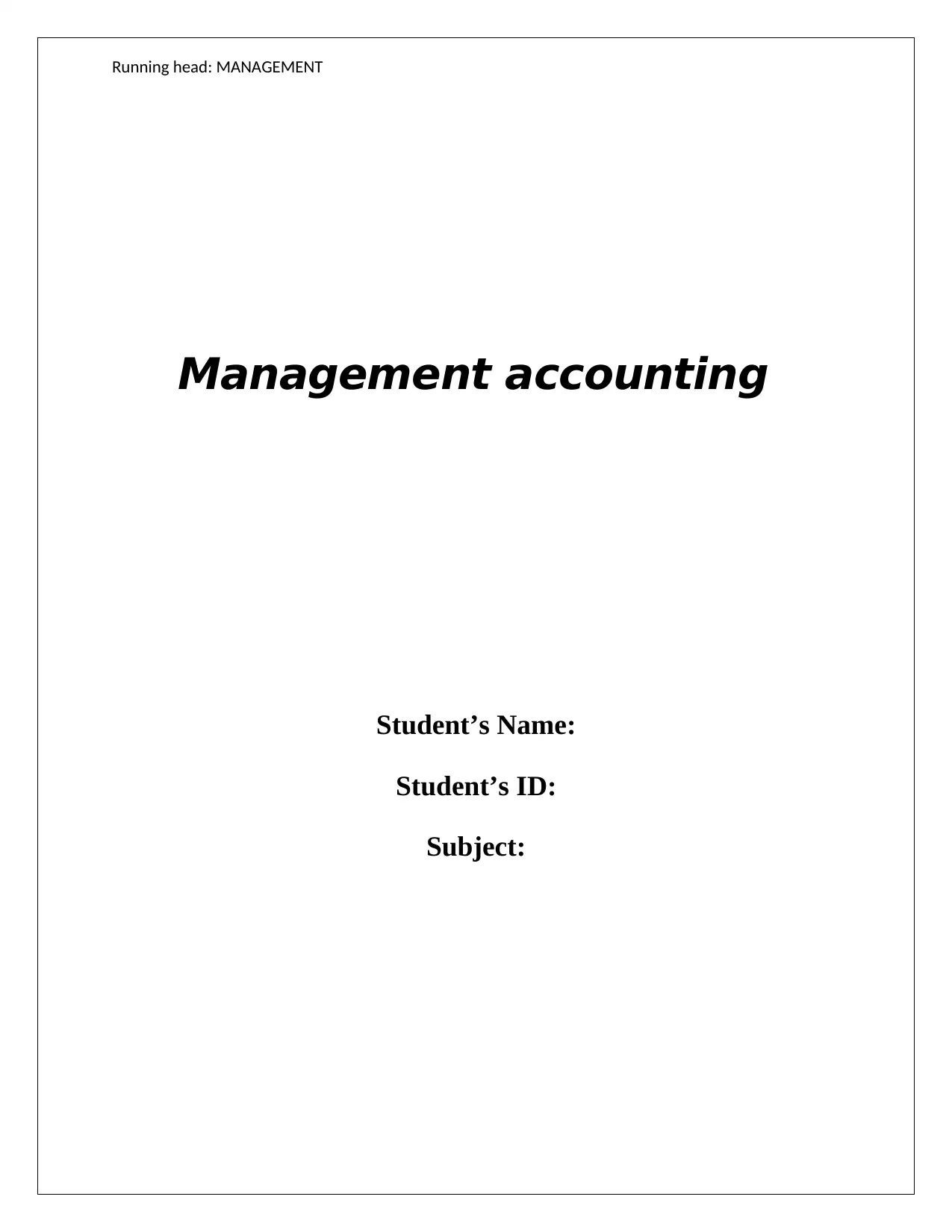
Running head: MANAGEMENT
Management accounting
Student’s Name:
Student’s ID:
Subject:
Management accounting
Student’s Name:
Student’s ID:
Subject:
Paraphrase This Document
Need a fresh take? Get an instant paraphrase of this document with our AI Paraphraser
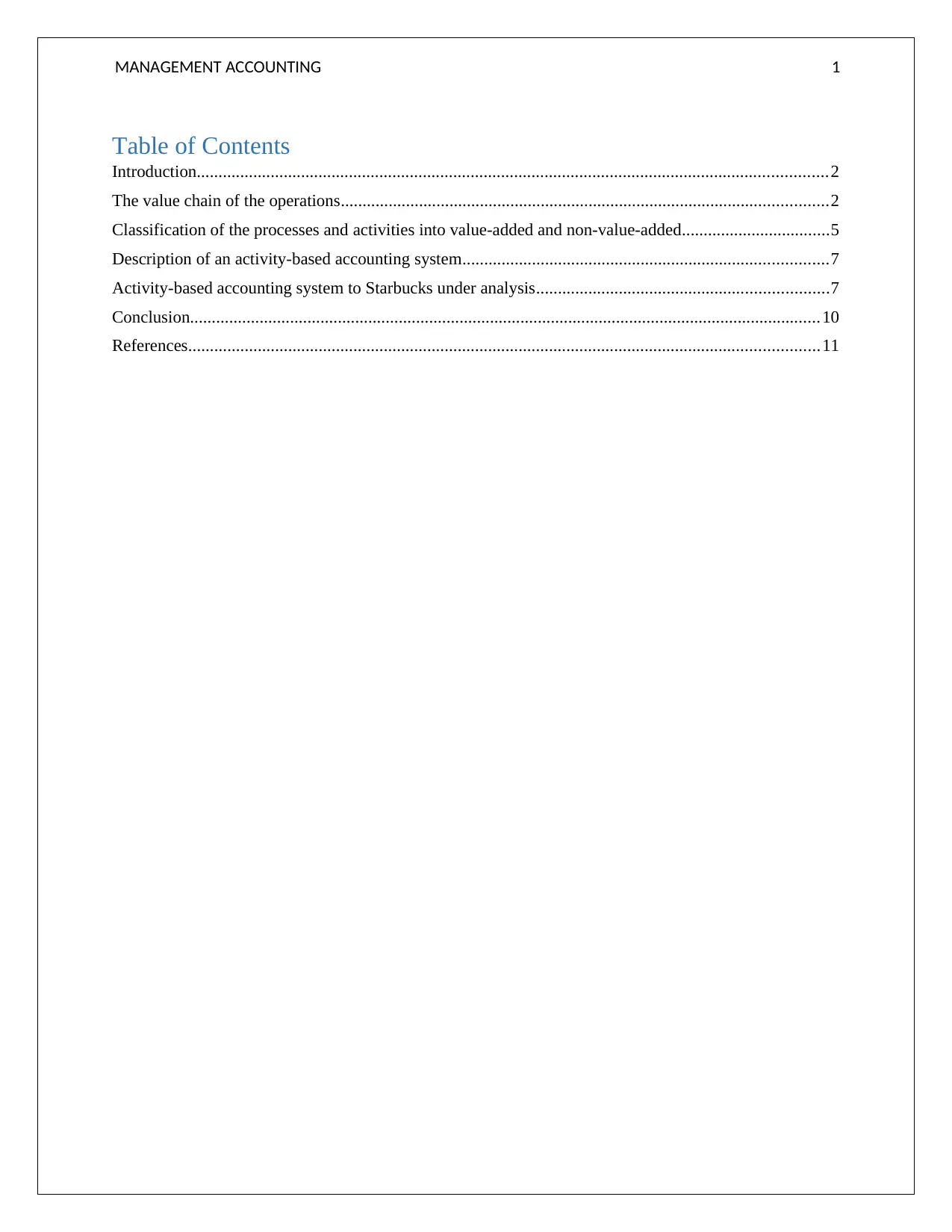
MANAGEMENT ACCOUNTING 1
Table of Contents
Introduction.................................................................................................................................................2
The value chain of the operations................................................................................................................2
Classification of the processes and activities into value-added and non-value-added..................................5
Description of an activity-based accounting system....................................................................................7
Activity-based accounting system to Starbucks under analysis...................................................................7
Conclusion.................................................................................................................................................10
References.................................................................................................................................................11
Table of Contents
Introduction.................................................................................................................................................2
The value chain of the operations................................................................................................................2
Classification of the processes and activities into value-added and non-value-added..................................5
Description of an activity-based accounting system....................................................................................7
Activity-based accounting system to Starbucks under analysis...................................................................7
Conclusion.................................................................................................................................................10
References.................................................................................................................................................11
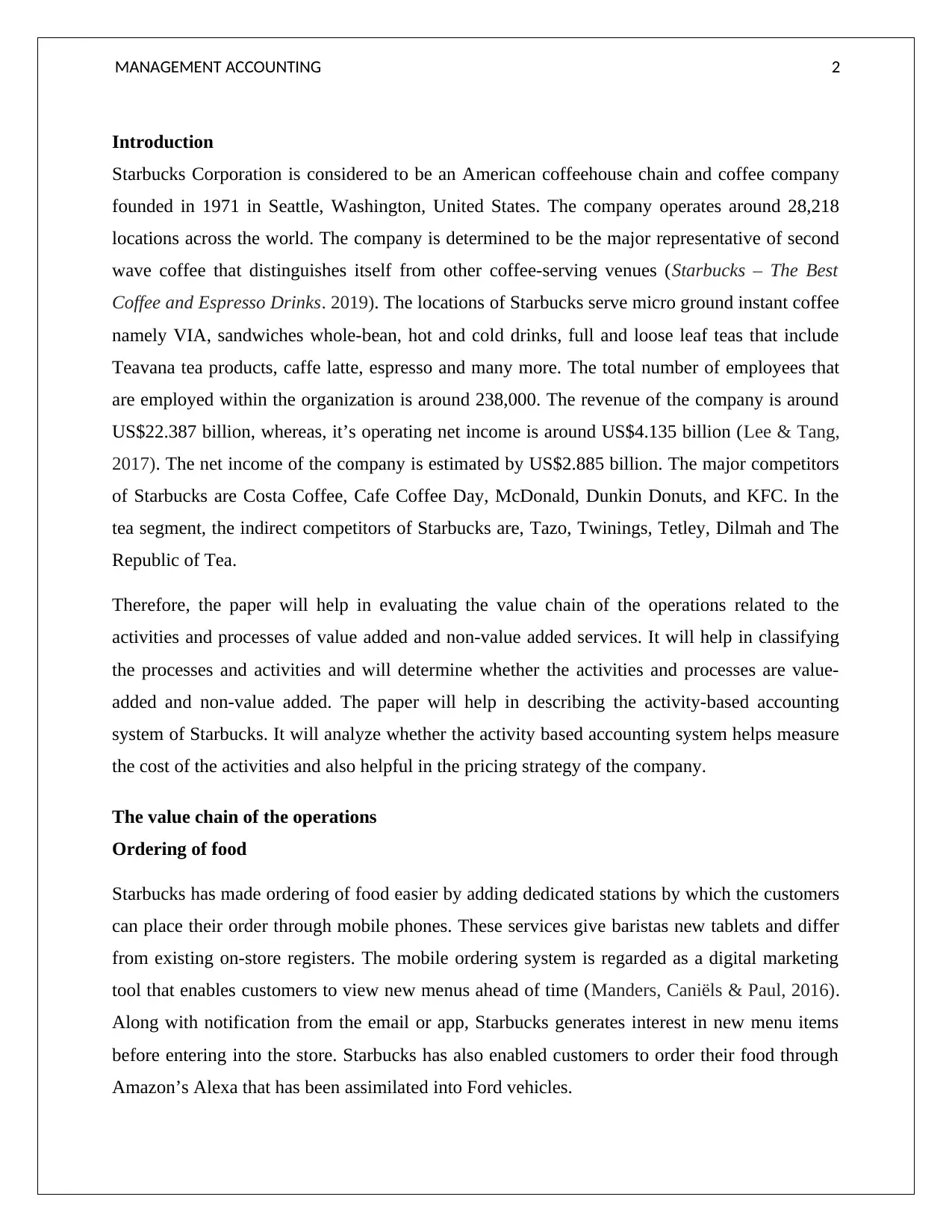
MANAGEMENT ACCOUNTING 2
Introduction
Starbucks Corporation is considered to be an American coffeehouse chain and coffee company
founded in 1971 in Seattle, Washington, United States. The company operates around 28,218
locations across the world. The company is determined to be the major representative of second
wave coffee that distinguishes itself from other coffee-serving venues (Starbucks – The Best
Coffee and Espresso Drinks. 2019). The locations of Starbucks serve micro ground instant coffee
namely VIA, sandwiches whole-bean, hot and cold drinks, full and loose leaf teas that include
Teavana tea products, caffe latte, espresso and many more. The total number of employees that
are employed within the organization is around 238,000. The revenue of the company is around
US$22.387 billion, whereas, it’s operating net income is around US$4.135 billion (Lee & Tang,
2017). The net income of the company is estimated by US$2.885 billion. The major competitors
of Starbucks are Costa Coffee, Cafe Coffee Day, McDonald, Dunkin Donuts, and KFC. In the
tea segment, the indirect competitors of Starbucks are, Tazo, Twinings, Tetley, Dilmah and The
Republic of Tea.
Therefore, the paper will help in evaluating the value chain of the operations related to the
activities and processes of value added and non-value added services. It will help in classifying
the processes and activities and will determine whether the activities and processes are value-
added and non-value added. The paper will help in describing the activity-based accounting
system of Starbucks. It will analyze whether the activity based accounting system helps measure
the cost of the activities and also helpful in the pricing strategy of the company.
The value chain of the operations
Ordering of food
Starbucks has made ordering of food easier by adding dedicated stations by which the customers
can place their order through mobile phones. These services give baristas new tablets and differ
from existing on-store registers. The mobile ordering system is regarded as a digital marketing
tool that enables customers to view new menus ahead of time (Manders, Caniëls & Paul, 2016).
Along with notification from the email or app, Starbucks generates interest in new menu items
before entering into the store. Starbucks has also enabled customers to order their food through
Amazon’s Alexa that has been assimilated into Ford vehicles.
Introduction
Starbucks Corporation is considered to be an American coffeehouse chain and coffee company
founded in 1971 in Seattle, Washington, United States. The company operates around 28,218
locations across the world. The company is determined to be the major representative of second
wave coffee that distinguishes itself from other coffee-serving venues (Starbucks – The Best
Coffee and Espresso Drinks. 2019). The locations of Starbucks serve micro ground instant coffee
namely VIA, sandwiches whole-bean, hot and cold drinks, full and loose leaf teas that include
Teavana tea products, caffe latte, espresso and many more. The total number of employees that
are employed within the organization is around 238,000. The revenue of the company is around
US$22.387 billion, whereas, it’s operating net income is around US$4.135 billion (Lee & Tang,
2017). The net income of the company is estimated by US$2.885 billion. The major competitors
of Starbucks are Costa Coffee, Cafe Coffee Day, McDonald, Dunkin Donuts, and KFC. In the
tea segment, the indirect competitors of Starbucks are, Tazo, Twinings, Tetley, Dilmah and The
Republic of Tea.
Therefore, the paper will help in evaluating the value chain of the operations related to the
activities and processes of value added and non-value added services. It will help in classifying
the processes and activities and will determine whether the activities and processes are value-
added and non-value added. The paper will help in describing the activity-based accounting
system of Starbucks. It will analyze whether the activity based accounting system helps measure
the cost of the activities and also helpful in the pricing strategy of the company.
The value chain of the operations
Ordering of food
Starbucks has made ordering of food easier by adding dedicated stations by which the customers
can place their order through mobile phones. These services give baristas new tablets and differ
from existing on-store registers. The mobile ordering system is regarded as a digital marketing
tool that enables customers to view new menus ahead of time (Manders, Caniëls & Paul, 2016).
Along with notification from the email or app, Starbucks generates interest in new menu items
before entering into the store. Starbucks has also enabled customers to order their food through
Amazon’s Alexa that has been assimilated into Ford vehicles.
⊘ This is a preview!⊘
Do you want full access?
Subscribe today to unlock all pages.

Trusted by 1+ million students worldwide
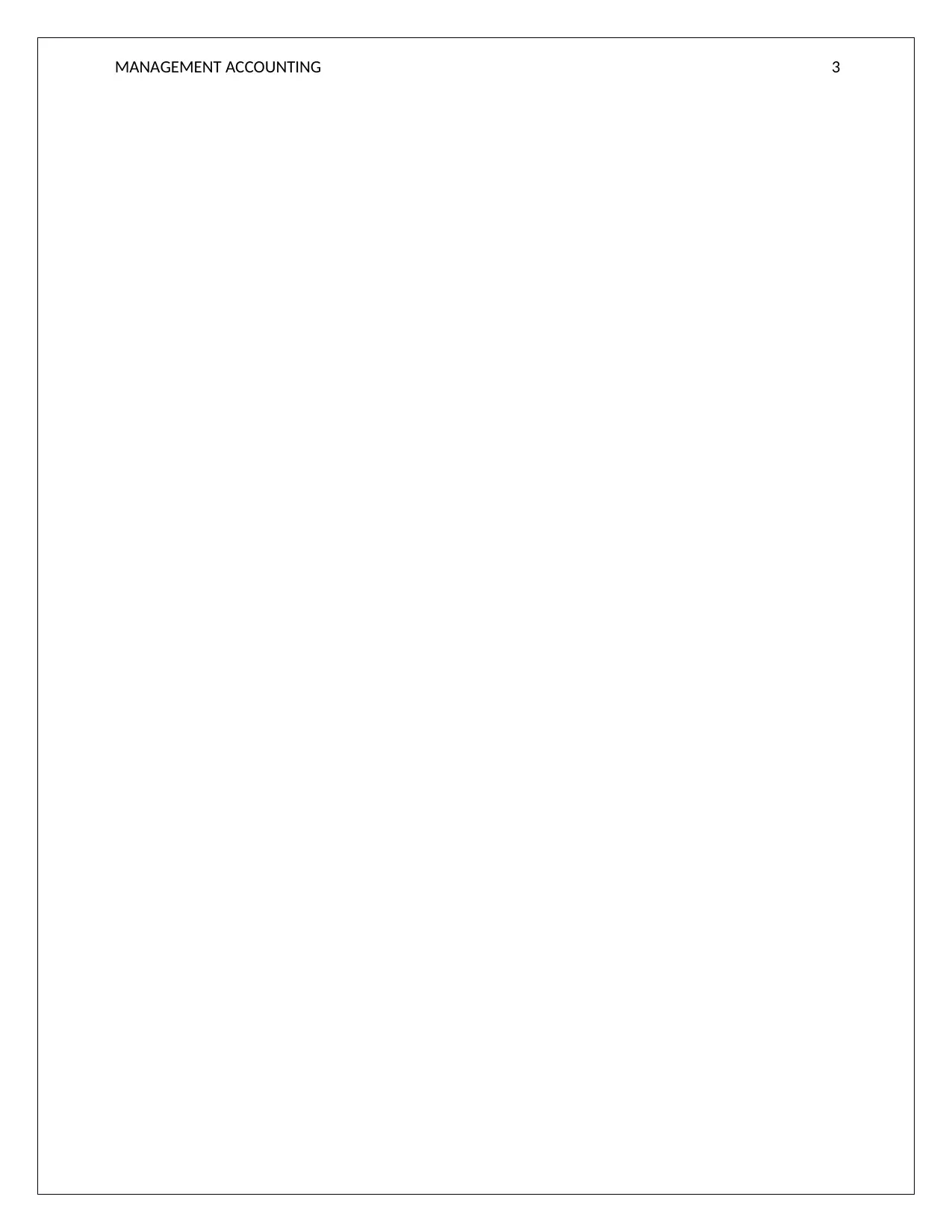
MANAGEMENT ACCOUNTING 3
Paraphrase This Document
Need a fresh take? Get an instant paraphrase of this document with our AI Paraphraser
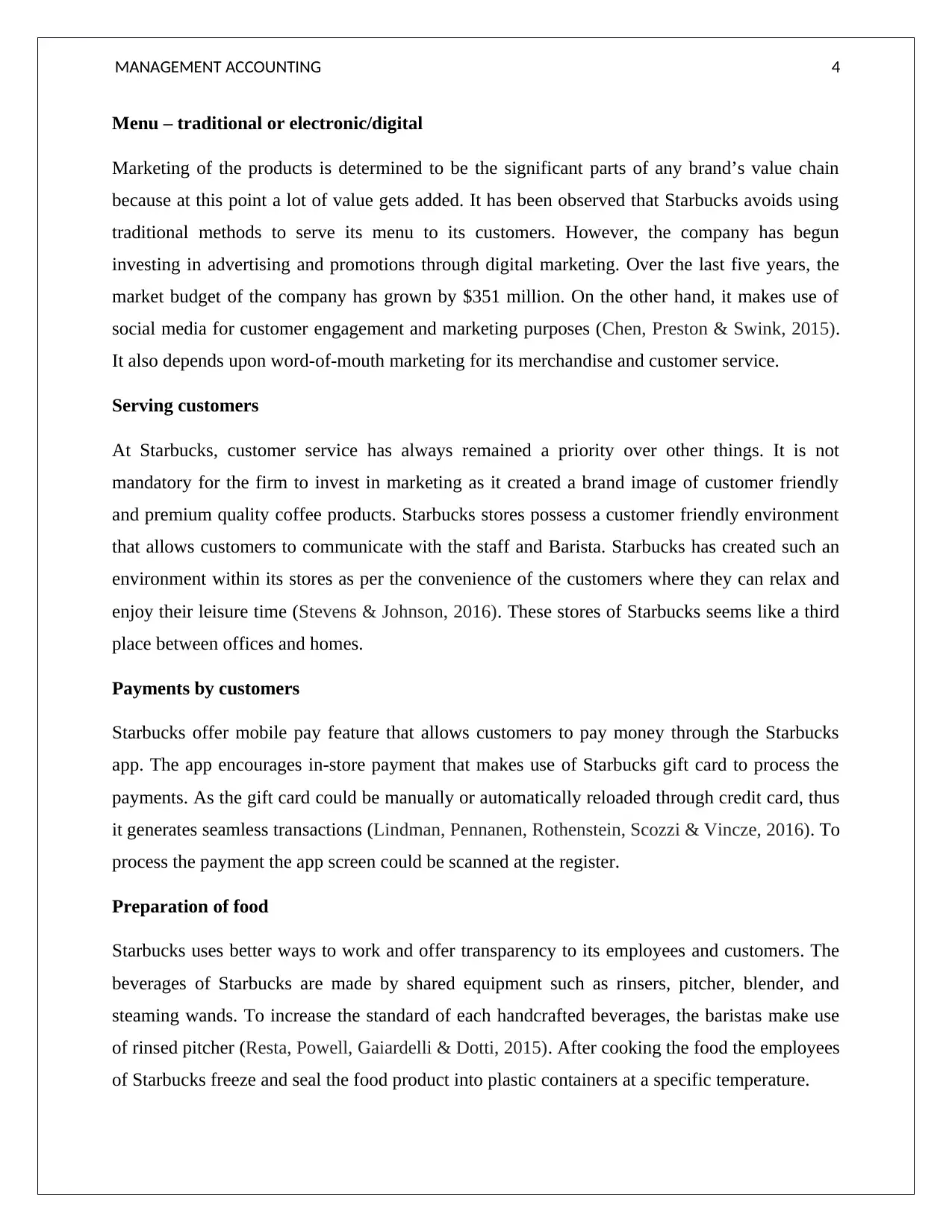
MANAGEMENT ACCOUNTING 4
Menu – traditional or electronic/digital
Marketing of the products is determined to be the significant parts of any brand’s value chain
because at this point a lot of value gets added. It has been observed that Starbucks avoids using
traditional methods to serve its menu to its customers. However, the company has begun
investing in advertising and promotions through digital marketing. Over the last five years, the
market budget of the company has grown by $351 million. On the other hand, it makes use of
social media for customer engagement and marketing purposes (Chen, Preston & Swink, 2015).
It also depends upon word-of-mouth marketing for its merchandise and customer service.
Serving customers
At Starbucks, customer service has always remained a priority over other things. It is not
mandatory for the firm to invest in marketing as it created a brand image of customer friendly
and premium quality coffee products. Starbucks stores possess a customer friendly environment
that allows customers to communicate with the staff and Barista. Starbucks has created such an
environment within its stores as per the convenience of the customers where they can relax and
enjoy their leisure time (Stevens & Johnson, 2016). These stores of Starbucks seems like a third
place between offices and homes.
Payments by customers
Starbucks offer mobile pay feature that allows customers to pay money through the Starbucks
app. The app encourages in-store payment that makes use of Starbucks gift card to process the
payments. As the gift card could be manually or automatically reloaded through credit card, thus
it generates seamless transactions (Lindman, Pennanen, Rothenstein, Scozzi & Vincze, 2016). To
process the payment the app screen could be scanned at the register.
Preparation of food
Starbucks uses better ways to work and offer transparency to its employees and customers. The
beverages of Starbucks are made by shared equipment such as rinsers, pitcher, blender, and
steaming wands. To increase the standard of each handcrafted beverages, the baristas make use
of rinsed pitcher (Resta, Powell, Gaiardelli & Dotti, 2015). After cooking the food the employees
of Starbucks freeze and seal the food product into plastic containers at a specific temperature.
Menu – traditional or electronic/digital
Marketing of the products is determined to be the significant parts of any brand’s value chain
because at this point a lot of value gets added. It has been observed that Starbucks avoids using
traditional methods to serve its menu to its customers. However, the company has begun
investing in advertising and promotions through digital marketing. Over the last five years, the
market budget of the company has grown by $351 million. On the other hand, it makes use of
social media for customer engagement and marketing purposes (Chen, Preston & Swink, 2015).
It also depends upon word-of-mouth marketing for its merchandise and customer service.
Serving customers
At Starbucks, customer service has always remained a priority over other things. It is not
mandatory for the firm to invest in marketing as it created a brand image of customer friendly
and premium quality coffee products. Starbucks stores possess a customer friendly environment
that allows customers to communicate with the staff and Barista. Starbucks has created such an
environment within its stores as per the convenience of the customers where they can relax and
enjoy their leisure time (Stevens & Johnson, 2016). These stores of Starbucks seems like a third
place between offices and homes.
Payments by customers
Starbucks offer mobile pay feature that allows customers to pay money through the Starbucks
app. The app encourages in-store payment that makes use of Starbucks gift card to process the
payments. As the gift card could be manually or automatically reloaded through credit card, thus
it generates seamless transactions (Lindman, Pennanen, Rothenstein, Scozzi & Vincze, 2016). To
process the payment the app screen could be scanned at the register.
Preparation of food
Starbucks uses better ways to work and offer transparency to its employees and customers. The
beverages of Starbucks are made by shared equipment such as rinsers, pitcher, blender, and
steaming wands. To increase the standard of each handcrafted beverages, the baristas make use
of rinsed pitcher (Resta, Powell, Gaiardelli & Dotti, 2015). After cooking the food the employees
of Starbucks freeze and seal the food product into plastic containers at a specific temperature.
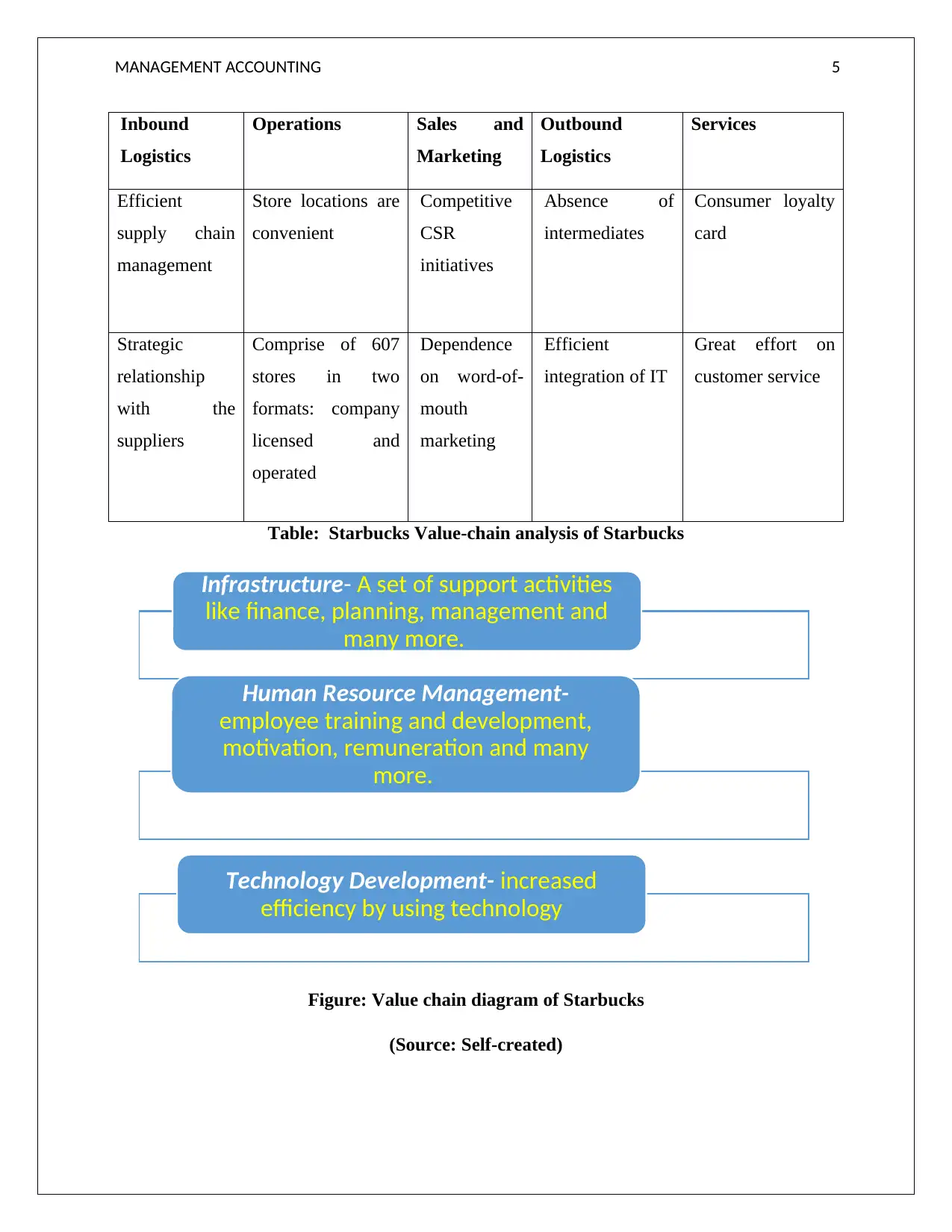
MANAGEMENT ACCOUNTING 5
Inbound
Logistics
Operations Sales and
Marketing
Outbound
Logistics
Services
Efficient
supply chain
management
Store locations are
convenient
Competitive
CSR
initiatives
Absence of
intermediates
Consumer loyalty
card
Strategic
relationship
with the
suppliers
Comprise of 607
stores in two
formats: company
licensed and
operated
Dependence
on word-of-
mouth
marketing
Efficient
integration of IT
Great effort on
customer service
Table: Starbucks Value-chain analysis of Starbucks
Figure: Value chain diagram of Starbucks
(Source: Self-created)
Infrastructure- A set of support activities
like finance, planning, management and
many more.
Human Resource Management-
employee training and development,
motivation, remuneration and many
more.
Technology Development- increased
efficiency by using technology
Inbound
Logistics
Operations Sales and
Marketing
Outbound
Logistics
Services
Efficient
supply chain
management
Store locations are
convenient
Competitive
CSR
initiatives
Absence of
intermediates
Consumer loyalty
card
Strategic
relationship
with the
suppliers
Comprise of 607
stores in two
formats: company
licensed and
operated
Dependence
on word-of-
mouth
marketing
Efficient
integration of IT
Great effort on
customer service
Table: Starbucks Value-chain analysis of Starbucks
Figure: Value chain diagram of Starbucks
(Source: Self-created)
Infrastructure- A set of support activities
like finance, planning, management and
many more.
Human Resource Management-
employee training and development,
motivation, remuneration and many
more.
Technology Development- increased
efficiency by using technology
⊘ This is a preview!⊘
Do you want full access?
Subscribe today to unlock all pages.

Trusted by 1+ million students worldwide
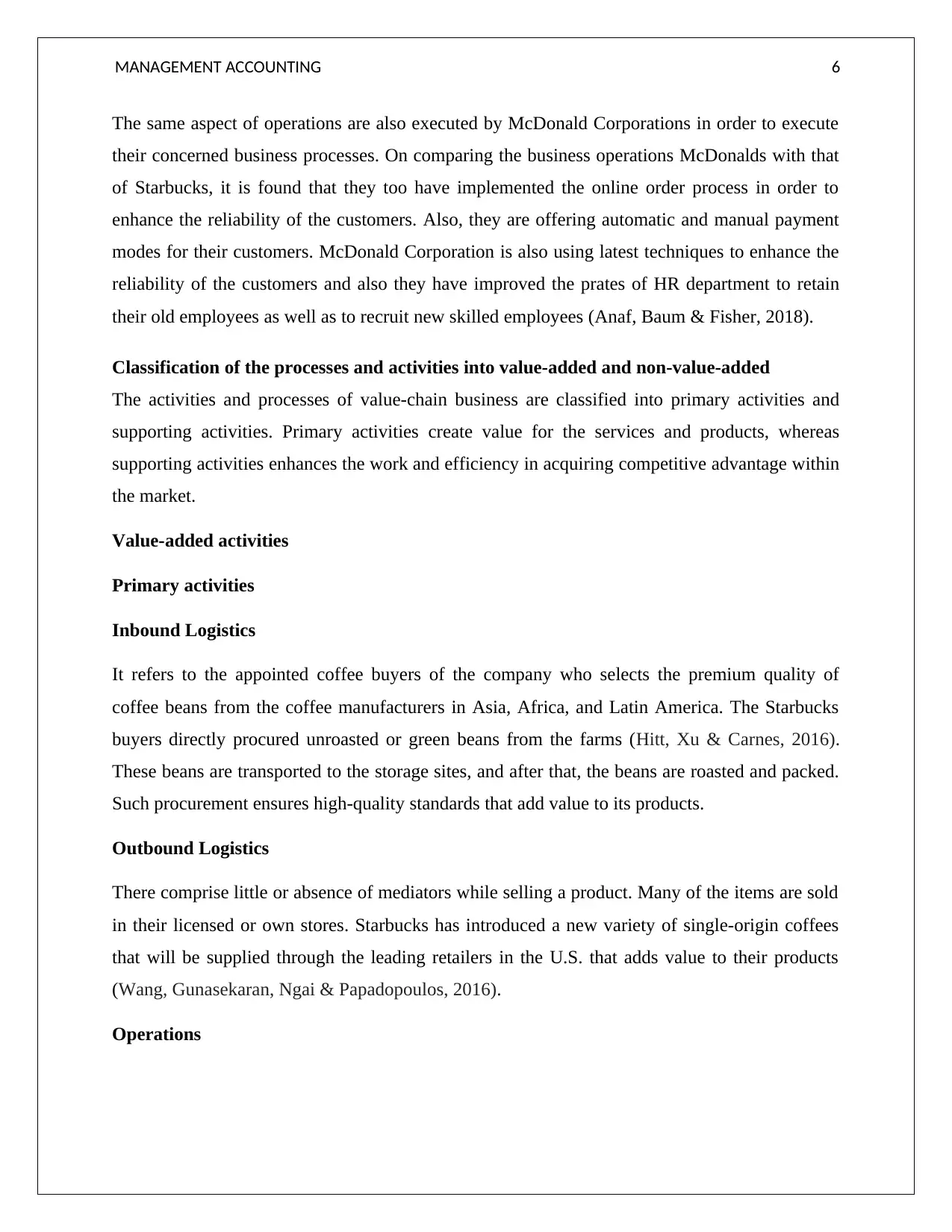
MANAGEMENT ACCOUNTING 6
The same aspect of operations are also executed by McDonald Corporations in order to execute
their concerned business processes. On comparing the business operations McDonalds with that
of Starbucks, it is found that they too have implemented the online order process in order to
enhance the reliability of the customers. Also, they are offering automatic and manual payment
modes for their customers. McDonald Corporation is also using latest techniques to enhance the
reliability of the customers and also they have improved the prates of HR department to retain
their old employees as well as to recruit new skilled employees (Anaf, Baum & Fisher, 2018).
Classification of the processes and activities into value-added and non-value-added
The activities and processes of value-chain business are classified into primary activities and
supporting activities. Primary activities create value for the services and products, whereas
supporting activities enhances the work and efficiency in acquiring competitive advantage within
the market.
Value-added activities
Primary activities
Inbound Logistics
It refers to the appointed coffee buyers of the company who selects the premium quality of
coffee beans from the coffee manufacturers in Asia, Africa, and Latin America. The Starbucks
buyers directly procured unroasted or green beans from the farms (Hitt, Xu & Carnes, 2016).
These beans are transported to the storage sites, and after that, the beans are roasted and packed.
Such procurement ensures high-quality standards that add value to its products.
Outbound Logistics
There comprise little or absence of mediators while selling a product. Many of the items are sold
in their licensed or own stores. Starbucks has introduced a new variety of single-origin coffees
that will be supplied through the leading retailers in the U.S. that adds value to their products
(Wang, Gunasekaran, Ngai & Papadopoulos, 2016).
Operations
The same aspect of operations are also executed by McDonald Corporations in order to execute
their concerned business processes. On comparing the business operations McDonalds with that
of Starbucks, it is found that they too have implemented the online order process in order to
enhance the reliability of the customers. Also, they are offering automatic and manual payment
modes for their customers. McDonald Corporation is also using latest techniques to enhance the
reliability of the customers and also they have improved the prates of HR department to retain
their old employees as well as to recruit new skilled employees (Anaf, Baum & Fisher, 2018).
Classification of the processes and activities into value-added and non-value-added
The activities and processes of value-chain business are classified into primary activities and
supporting activities. Primary activities create value for the services and products, whereas
supporting activities enhances the work and efficiency in acquiring competitive advantage within
the market.
Value-added activities
Primary activities
Inbound Logistics
It refers to the appointed coffee buyers of the company who selects the premium quality of
coffee beans from the coffee manufacturers in Asia, Africa, and Latin America. The Starbucks
buyers directly procured unroasted or green beans from the farms (Hitt, Xu & Carnes, 2016).
These beans are transported to the storage sites, and after that, the beans are roasted and packed.
Such procurement ensures high-quality standards that add value to its products.
Outbound Logistics
There comprise little or absence of mediators while selling a product. Many of the items are sold
in their licensed or own stores. Starbucks has introduced a new variety of single-origin coffees
that will be supplied through the leading retailers in the U.S. that adds value to their products
(Wang, Gunasekaran, Ngai & Papadopoulos, 2016).
Operations
Paraphrase This Document
Need a fresh take? Get an instant paraphrase of this document with our AI Paraphraser
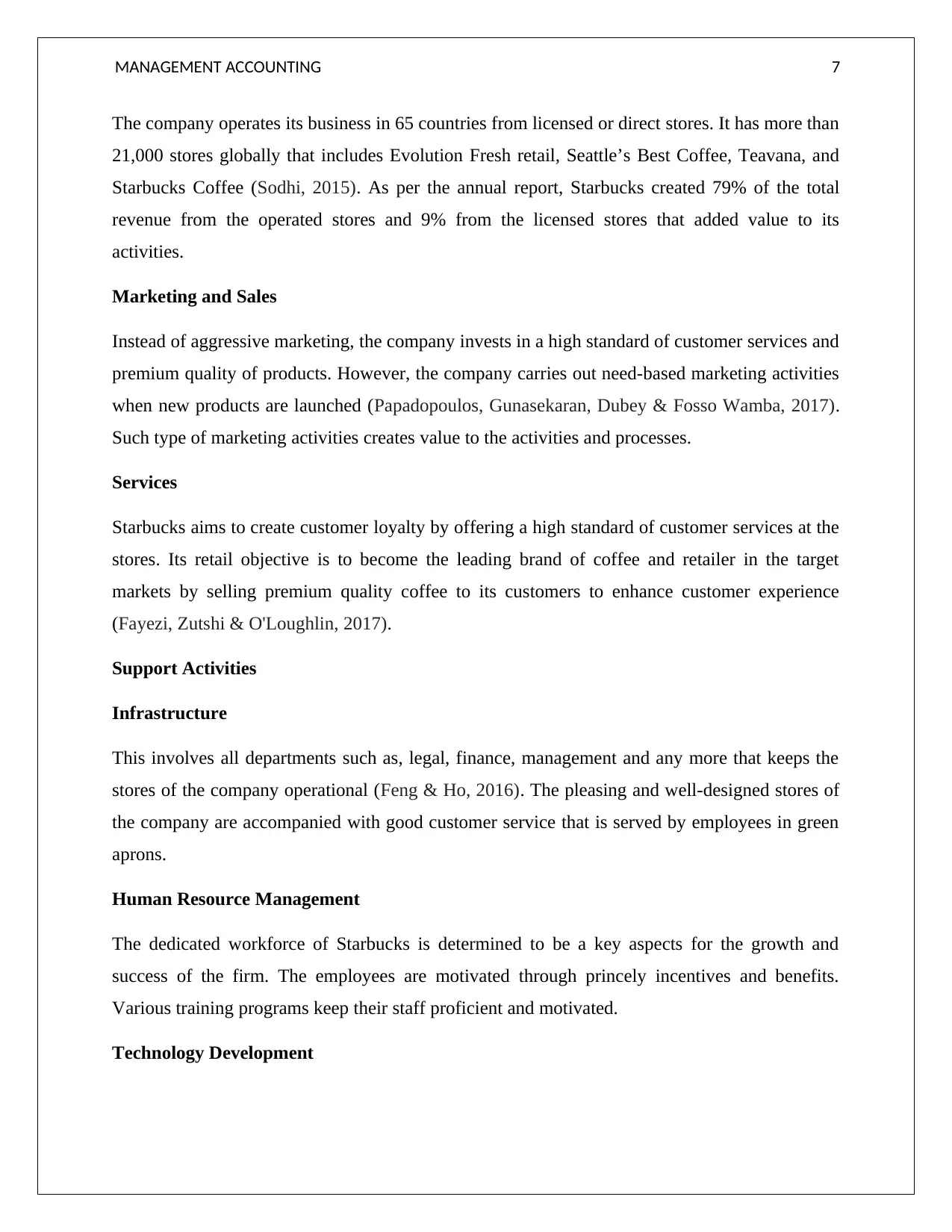
MANAGEMENT ACCOUNTING 7
The company operates its business in 65 countries from licensed or direct stores. It has more than
21,000 stores globally that includes Evolution Fresh retail, Seattle’s Best Coffee, Teavana, and
Starbucks Coffee (Sodhi, 2015). As per the annual report, Starbucks created 79% of the total
revenue from the operated stores and 9% from the licensed stores that added value to its
activities.
Marketing and Sales
Instead of aggressive marketing, the company invests in a high standard of customer services and
premium quality of products. However, the company carries out need-based marketing activities
when new products are launched (Papadopoulos, Gunasekaran, Dubey & Fosso Wamba, 2017).
Such type of marketing activities creates value to the activities and processes.
Services
Starbucks aims to create customer loyalty by offering a high standard of customer services at the
stores. Its retail objective is to become the leading brand of coffee and retailer in the target
markets by selling premium quality coffee to its customers to enhance customer experience
(Fayezi, Zutshi & O'Loughlin, 2017).
Support Activities
Infrastructure
This involves all departments such as, legal, finance, management and any more that keeps the
stores of the company operational (Feng & Ho, 2016). The pleasing and well-designed stores of
the company are accompanied with good customer service that is served by employees in green
aprons.
Human Resource Management
The dedicated workforce of Starbucks is determined to be a key aspects for the growth and
success of the firm. The employees are motivated through princely incentives and benefits.
Various training programs keep their staff proficient and motivated.
Technology Development
The company operates its business in 65 countries from licensed or direct stores. It has more than
21,000 stores globally that includes Evolution Fresh retail, Seattle’s Best Coffee, Teavana, and
Starbucks Coffee (Sodhi, 2015). As per the annual report, Starbucks created 79% of the total
revenue from the operated stores and 9% from the licensed stores that added value to its
activities.
Marketing and Sales
Instead of aggressive marketing, the company invests in a high standard of customer services and
premium quality of products. However, the company carries out need-based marketing activities
when new products are launched (Papadopoulos, Gunasekaran, Dubey & Fosso Wamba, 2017).
Such type of marketing activities creates value to the activities and processes.
Services
Starbucks aims to create customer loyalty by offering a high standard of customer services at the
stores. Its retail objective is to become the leading brand of coffee and retailer in the target
markets by selling premium quality coffee to its customers to enhance customer experience
(Fayezi, Zutshi & O'Loughlin, 2017).
Support Activities
Infrastructure
This involves all departments such as, legal, finance, management and any more that keeps the
stores of the company operational (Feng & Ho, 2016). The pleasing and well-designed stores of
the company are accompanied with good customer service that is served by employees in green
aprons.
Human Resource Management
The dedicated workforce of Starbucks is determined to be a key aspects for the growth and
success of the firm. The employees are motivated through princely incentives and benefits.
Various training programs keep their staff proficient and motivated.
Technology Development
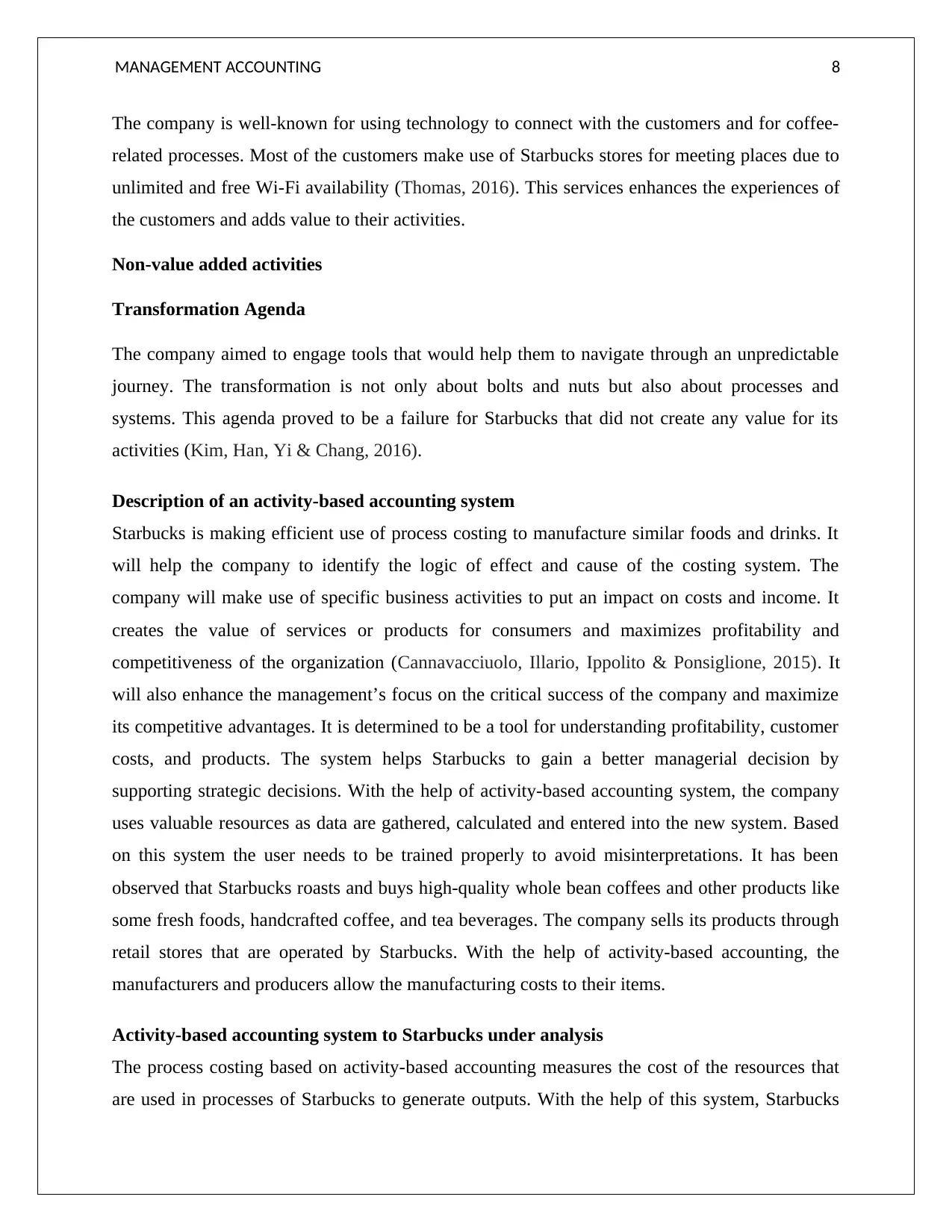
MANAGEMENT ACCOUNTING 8
The company is well-known for using technology to connect with the customers and for coffee-
related processes. Most of the customers make use of Starbucks stores for meeting places due to
unlimited and free Wi-Fi availability (Thomas, 2016). This services enhances the experiences of
the customers and adds value to their activities.
Non-value added activities
Transformation Agenda
The company aimed to engage tools that would help them to navigate through an unpredictable
journey. The transformation is not only about bolts and nuts but also about processes and
systems. This agenda proved to be a failure for Starbucks that did not create any value for its
activities (Kim, Han, Yi & Chang, 2016).
Description of an activity-based accounting system
Starbucks is making efficient use of process costing to manufacture similar foods and drinks. It
will help the company to identify the logic of effect and cause of the costing system. The
company will make use of specific business activities to put an impact on costs and income. It
creates the value of services or products for consumers and maximizes profitability and
competitiveness of the organization (Cannavacciuolo, Illario, Ippolito & Ponsiglione, 2015). It
will also enhance the management’s focus on the critical success of the company and maximize
its competitive advantages. It is determined to be a tool for understanding profitability, customer
costs, and products. The system helps Starbucks to gain a better managerial decision by
supporting strategic decisions. With the help of activity-based accounting system, the company
uses valuable resources as data are gathered, calculated and entered into the new system. Based
on this system the user needs to be trained properly to avoid misinterpretations. It has been
observed that Starbucks roasts and buys high-quality whole bean coffees and other products like
some fresh foods, handcrafted coffee, and tea beverages. The company sells its products through
retail stores that are operated by Starbucks. With the help of activity-based accounting, the
manufacturers and producers allow the manufacturing costs to their items.
Activity-based accounting system to Starbucks under analysis
The process costing based on activity-based accounting measures the cost of the resources that
are used in processes of Starbucks to generate outputs. With the help of this system, Starbucks
The company is well-known for using technology to connect with the customers and for coffee-
related processes. Most of the customers make use of Starbucks stores for meeting places due to
unlimited and free Wi-Fi availability (Thomas, 2016). This services enhances the experiences of
the customers and adds value to their activities.
Non-value added activities
Transformation Agenda
The company aimed to engage tools that would help them to navigate through an unpredictable
journey. The transformation is not only about bolts and nuts but also about processes and
systems. This agenda proved to be a failure for Starbucks that did not create any value for its
activities (Kim, Han, Yi & Chang, 2016).
Description of an activity-based accounting system
Starbucks is making efficient use of process costing to manufacture similar foods and drinks. It
will help the company to identify the logic of effect and cause of the costing system. The
company will make use of specific business activities to put an impact on costs and income. It
creates the value of services or products for consumers and maximizes profitability and
competitiveness of the organization (Cannavacciuolo, Illario, Ippolito & Ponsiglione, 2015). It
will also enhance the management’s focus on the critical success of the company and maximize
its competitive advantages. It is determined to be a tool for understanding profitability, customer
costs, and products. The system helps Starbucks to gain a better managerial decision by
supporting strategic decisions. With the help of activity-based accounting system, the company
uses valuable resources as data are gathered, calculated and entered into the new system. Based
on this system the user needs to be trained properly to avoid misinterpretations. It has been
observed that Starbucks roasts and buys high-quality whole bean coffees and other products like
some fresh foods, handcrafted coffee, and tea beverages. The company sells its products through
retail stores that are operated by Starbucks. With the help of activity-based accounting, the
manufacturers and producers allow the manufacturing costs to their items.
Activity-based accounting system to Starbucks under analysis
The process costing based on activity-based accounting measures the cost of the resources that
are used in processes of Starbucks to generate outputs. With the help of this system, Starbucks
⊘ This is a preview!⊘
Do you want full access?
Subscribe today to unlock all pages.

Trusted by 1+ million students worldwide
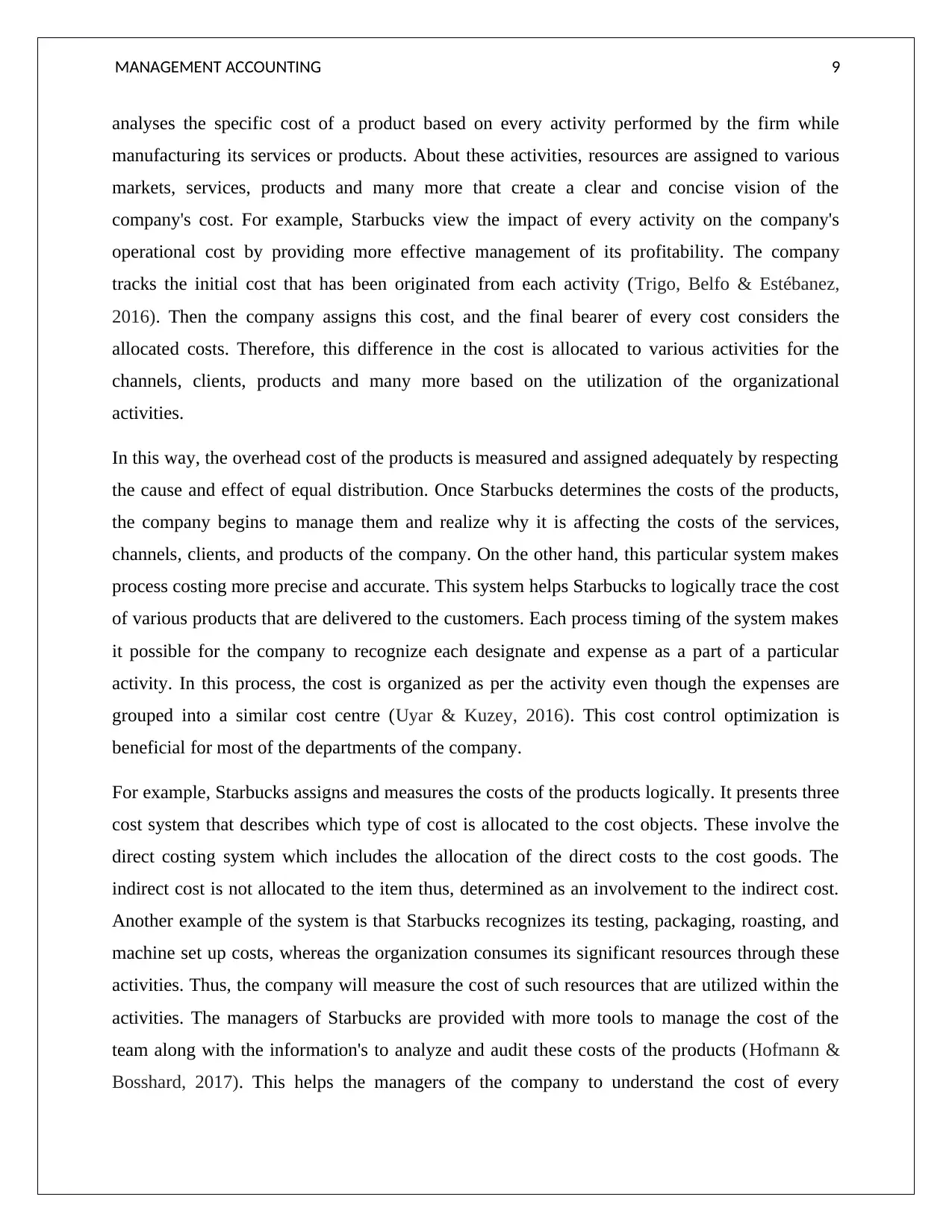
MANAGEMENT ACCOUNTING 9
analyses the specific cost of a product based on every activity performed by the firm while
manufacturing its services or products. About these activities, resources are assigned to various
markets, services, products and many more that create a clear and concise vision of the
company's cost. For example, Starbucks view the impact of every activity on the company's
operational cost by providing more effective management of its profitability. The company
tracks the initial cost that has been originated from each activity (Trigo, Belfo & Estébanez,
2016). Then the company assigns this cost, and the final bearer of every cost considers the
allocated costs. Therefore, this difference in the cost is allocated to various activities for the
channels, clients, products and many more based on the utilization of the organizational
activities.
In this way, the overhead cost of the products is measured and assigned adequately by respecting
the cause and effect of equal distribution. Once Starbucks determines the costs of the products,
the company begins to manage them and realize why it is affecting the costs of the services,
channels, clients, and products of the company. On the other hand, this particular system makes
process costing more precise and accurate. This system helps Starbucks to logically trace the cost
of various products that are delivered to the customers. Each process timing of the system makes
it possible for the company to recognize each designate and expense as a part of a particular
activity. In this process, the cost is organized as per the activity even though the expenses are
grouped into a similar cost centre (Uyar & Kuzey, 2016). This cost control optimization is
beneficial for most of the departments of the company.
For example, Starbucks assigns and measures the costs of the products logically. It presents three
cost system that describes which type of cost is allocated to the cost objects. These involve the
direct costing system which includes the allocation of the direct costs to the cost goods. The
indirect cost is not allocated to the item thus, determined as an involvement to the indirect cost.
Another example of the system is that Starbucks recognizes its testing, packaging, roasting, and
machine set up costs, whereas the organization consumes its significant resources through these
activities. Thus, the company will measure the cost of such resources that are utilized within the
activities. The managers of Starbucks are provided with more tools to manage the cost of the
team along with the information's to analyze and audit these costs of the products (Hofmann &
Bosshard, 2017). This helps the managers of the company to understand the cost of every
analyses the specific cost of a product based on every activity performed by the firm while
manufacturing its services or products. About these activities, resources are assigned to various
markets, services, products and many more that create a clear and concise vision of the
company's cost. For example, Starbucks view the impact of every activity on the company's
operational cost by providing more effective management of its profitability. The company
tracks the initial cost that has been originated from each activity (Trigo, Belfo & Estébanez,
2016). Then the company assigns this cost, and the final bearer of every cost considers the
allocated costs. Therefore, this difference in the cost is allocated to various activities for the
channels, clients, products and many more based on the utilization of the organizational
activities.
In this way, the overhead cost of the products is measured and assigned adequately by respecting
the cause and effect of equal distribution. Once Starbucks determines the costs of the products,
the company begins to manage them and realize why it is affecting the costs of the services,
channels, clients, and products of the company. On the other hand, this particular system makes
process costing more precise and accurate. This system helps Starbucks to logically trace the cost
of various products that are delivered to the customers. Each process timing of the system makes
it possible for the company to recognize each designate and expense as a part of a particular
activity. In this process, the cost is organized as per the activity even though the expenses are
grouped into a similar cost centre (Uyar & Kuzey, 2016). This cost control optimization is
beneficial for most of the departments of the company.
For example, Starbucks assigns and measures the costs of the products logically. It presents three
cost system that describes which type of cost is allocated to the cost objects. These involve the
direct costing system which includes the allocation of the direct costs to the cost goods. The
indirect cost is not allocated to the item thus, determined as an involvement to the indirect cost.
Another example of the system is that Starbucks recognizes its testing, packaging, roasting, and
machine set up costs, whereas the organization consumes its significant resources through these
activities. Thus, the company will measure the cost of such resources that are utilized within the
activities. The managers of Starbucks are provided with more tools to manage the cost of the
team along with the information's to analyze and audit these costs of the products (Hofmann &
Bosshard, 2017). This helps the managers of the company to understand the cost of every
Paraphrase This Document
Need a fresh take? Get an instant paraphrase of this document with our AI Paraphraser
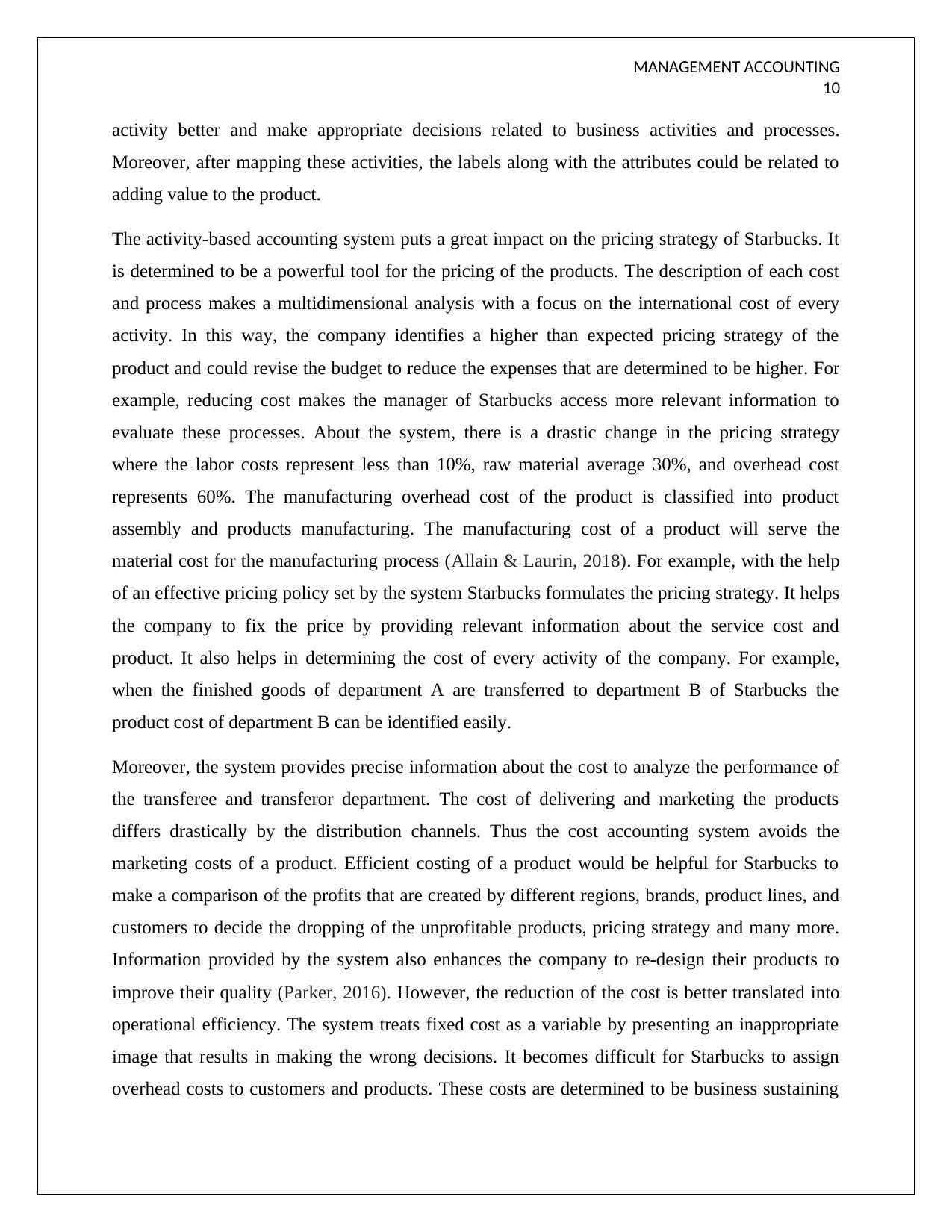
MANAGEMENT ACCOUNTING
10
activity better and make appropriate decisions related to business activities and processes.
Moreover, after mapping these activities, the labels along with the attributes could be related to
adding value to the product.
The activity-based accounting system puts a great impact on the pricing strategy of Starbucks. It
is determined to be a powerful tool for the pricing of the products. The description of each cost
and process makes a multidimensional analysis with a focus on the international cost of every
activity. In this way, the company identifies a higher than expected pricing strategy of the
product and could revise the budget to reduce the expenses that are determined to be higher. For
example, reducing cost makes the manager of Starbucks access more relevant information to
evaluate these processes. About the system, there is a drastic change in the pricing strategy
where the labor costs represent less than 10%, raw material average 30%, and overhead cost
represents 60%. The manufacturing overhead cost of the product is classified into product
assembly and products manufacturing. The manufacturing cost of a product will serve the
material cost for the manufacturing process (Allain & Laurin, 2018). For example, with the help
of an effective pricing policy set by the system Starbucks formulates the pricing strategy. It helps
the company to fix the price by providing relevant information about the service cost and
product. It also helps in determining the cost of every activity of the company. For example,
when the finished goods of department A are transferred to department B of Starbucks the
product cost of department B can be identified easily.
Moreover, the system provides precise information about the cost to analyze the performance of
the transferee and transferor department. The cost of delivering and marketing the products
differs drastically by the distribution channels. Thus the cost accounting system avoids the
marketing costs of a product. Efficient costing of a product would be helpful for Starbucks to
make a comparison of the profits that are created by different regions, brands, product lines, and
customers to decide the dropping of the unprofitable products, pricing strategy and many more.
Information provided by the system also enhances the company to re-design their products to
improve their quality (Parker, 2016). However, the reduction of the cost is better translated into
operational efficiency. The system treats fixed cost as a variable by presenting an inappropriate
image that results in making the wrong decisions. It becomes difficult for Starbucks to assign
overhead costs to customers and products. These costs are determined to be business sustaining
10
activity better and make appropriate decisions related to business activities and processes.
Moreover, after mapping these activities, the labels along with the attributes could be related to
adding value to the product.
The activity-based accounting system puts a great impact on the pricing strategy of Starbucks. It
is determined to be a powerful tool for the pricing of the products. The description of each cost
and process makes a multidimensional analysis with a focus on the international cost of every
activity. In this way, the company identifies a higher than expected pricing strategy of the
product and could revise the budget to reduce the expenses that are determined to be higher. For
example, reducing cost makes the manager of Starbucks access more relevant information to
evaluate these processes. About the system, there is a drastic change in the pricing strategy
where the labor costs represent less than 10%, raw material average 30%, and overhead cost
represents 60%. The manufacturing overhead cost of the product is classified into product
assembly and products manufacturing. The manufacturing cost of a product will serve the
material cost for the manufacturing process (Allain & Laurin, 2018). For example, with the help
of an effective pricing policy set by the system Starbucks formulates the pricing strategy. It helps
the company to fix the price by providing relevant information about the service cost and
product. It also helps in determining the cost of every activity of the company. For example,
when the finished goods of department A are transferred to department B of Starbucks the
product cost of department B can be identified easily.
Moreover, the system provides precise information about the cost to analyze the performance of
the transferee and transferor department. The cost of delivering and marketing the products
differs drastically by the distribution channels. Thus the cost accounting system avoids the
marketing costs of a product. Efficient costing of a product would be helpful for Starbucks to
make a comparison of the profits that are created by different regions, brands, product lines, and
customers to decide the dropping of the unprofitable products, pricing strategy and many more.
Information provided by the system also enhances the company to re-design their products to
improve their quality (Parker, 2016). However, the reduction of the cost is better translated into
operational efficiency. The system treats fixed cost as a variable by presenting an inappropriate
image that results in making the wrong decisions. It becomes difficult for Starbucks to assign
overhead costs to customers and products. These costs are determined to be business sustaining
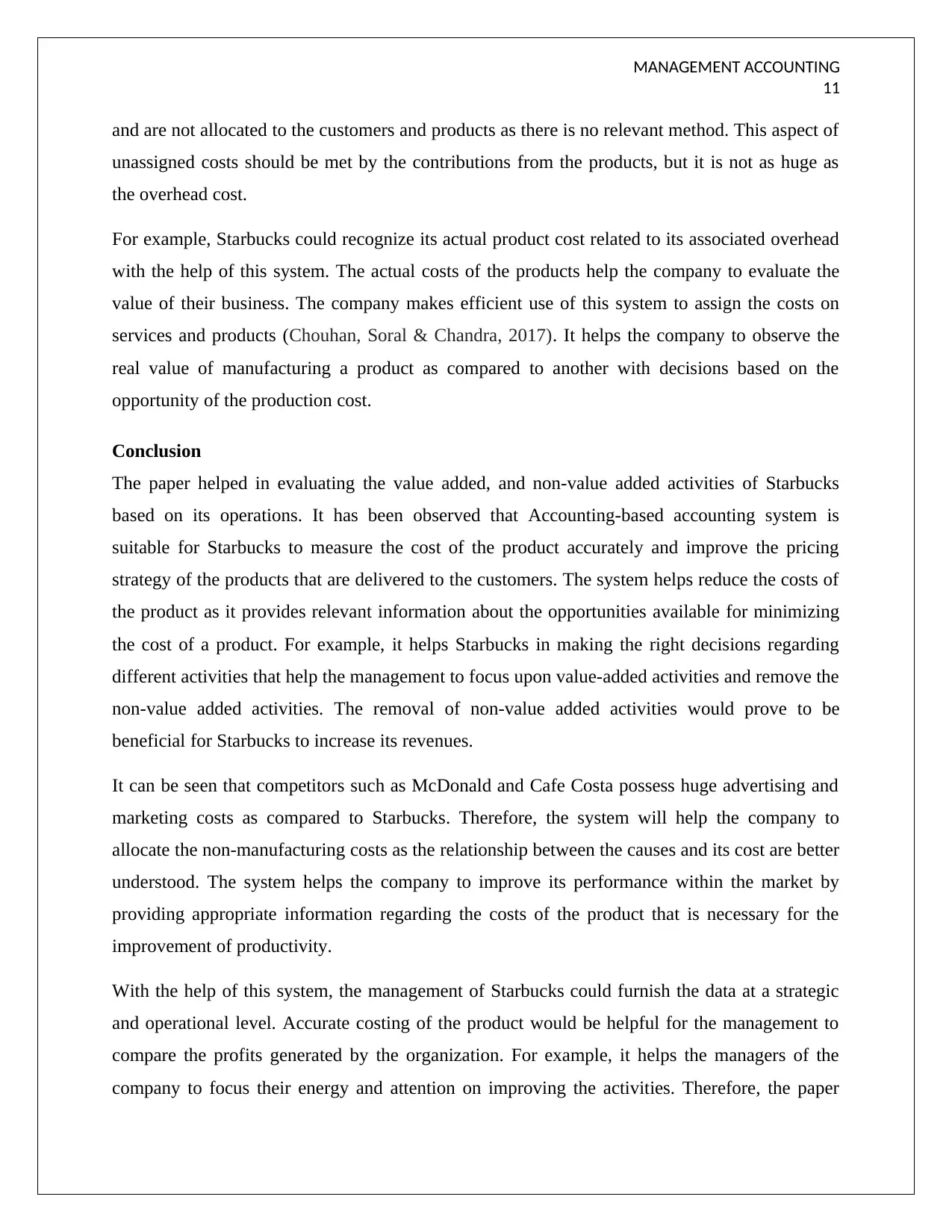
MANAGEMENT ACCOUNTING
11
and are not allocated to the customers and products as there is no relevant method. This aspect of
unassigned costs should be met by the contributions from the products, but it is not as huge as
the overhead cost.
For example, Starbucks could recognize its actual product cost related to its associated overhead
with the help of this system. The actual costs of the products help the company to evaluate the
value of their business. The company makes efficient use of this system to assign the costs on
services and products (Chouhan, Soral & Chandra, 2017). It helps the company to observe the
real value of manufacturing a product as compared to another with decisions based on the
opportunity of the production cost.
Conclusion
The paper helped in evaluating the value added, and non-value added activities of Starbucks
based on its operations. It has been observed that Accounting-based accounting system is
suitable for Starbucks to measure the cost of the product accurately and improve the pricing
strategy of the products that are delivered to the customers. The system helps reduce the costs of
the product as it provides relevant information about the opportunities available for minimizing
the cost of a product. For example, it helps Starbucks in making the right decisions regarding
different activities that help the management to focus upon value-added activities and remove the
non-value added activities. The removal of non-value added activities would prove to be
beneficial for Starbucks to increase its revenues.
It can be seen that competitors such as McDonald and Cafe Costa possess huge advertising and
marketing costs as compared to Starbucks. Therefore, the system will help the company to
allocate the non-manufacturing costs as the relationship between the causes and its cost are better
understood. The system helps the company to improve its performance within the market by
providing appropriate information regarding the costs of the product that is necessary for the
improvement of productivity.
With the help of this system, the management of Starbucks could furnish the data at a strategic
and operational level. Accurate costing of the product would be helpful for the management to
compare the profits generated by the organization. For example, it helps the managers of the
company to focus their energy and attention on improving the activities. Therefore, the paper
11
and are not allocated to the customers and products as there is no relevant method. This aspect of
unassigned costs should be met by the contributions from the products, but it is not as huge as
the overhead cost.
For example, Starbucks could recognize its actual product cost related to its associated overhead
with the help of this system. The actual costs of the products help the company to evaluate the
value of their business. The company makes efficient use of this system to assign the costs on
services and products (Chouhan, Soral & Chandra, 2017). It helps the company to observe the
real value of manufacturing a product as compared to another with decisions based on the
opportunity of the production cost.
Conclusion
The paper helped in evaluating the value added, and non-value added activities of Starbucks
based on its operations. It has been observed that Accounting-based accounting system is
suitable for Starbucks to measure the cost of the product accurately and improve the pricing
strategy of the products that are delivered to the customers. The system helps reduce the costs of
the product as it provides relevant information about the opportunities available for minimizing
the cost of a product. For example, it helps Starbucks in making the right decisions regarding
different activities that help the management to focus upon value-added activities and remove the
non-value added activities. The removal of non-value added activities would prove to be
beneficial for Starbucks to increase its revenues.
It can be seen that competitors such as McDonald and Cafe Costa possess huge advertising and
marketing costs as compared to Starbucks. Therefore, the system will help the company to
allocate the non-manufacturing costs as the relationship between the causes and its cost are better
understood. The system helps the company to improve its performance within the market by
providing appropriate information regarding the costs of the product that is necessary for the
improvement of productivity.
With the help of this system, the management of Starbucks could furnish the data at a strategic
and operational level. Accurate costing of the product would be helpful for the management to
compare the profits generated by the organization. For example, it helps the managers of the
company to focus their energy and attention on improving the activities. Therefore, the paper
⊘ This is a preview!⊘
Do you want full access?
Subscribe today to unlock all pages.

Trusted by 1+ million students worldwide
1 out of 15
Related Documents
Your All-in-One AI-Powered Toolkit for Academic Success.
+13062052269
info@desklib.com
Available 24*7 on WhatsApp / Email
![[object Object]](/_next/static/media/star-bottom.7253800d.svg)
Unlock your academic potential
Copyright © 2020–2025 A2Z Services. All Rights Reserved. Developed and managed by ZUCOL.





